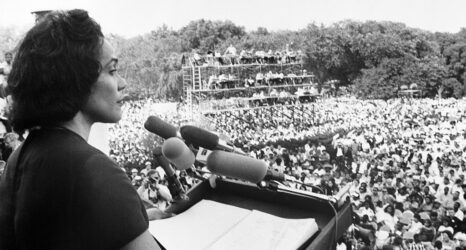The impressive box office haul of Woody Allen’s 2011 romantic comedy Midnight in Paris testifies to Americans’ ongoing love affair with a city known for high culture, grand architecture and romance. That fondness has been tested in recent years by a weak dollar, “freedom fries” and the unqualified French resistance to the ill-advised American invasion of Iraq. But Allen’s film tapped into a well of nostalgia surrounding the roaring 20s and the twilight years of the 1930s, the Jazz Age, when a much stronger dollar allowed a “lost generation” of artists and intellectuals to take refuge in the open arms of the City of Light.
What motivated me to attend an early afternoon screening of the film at a San Francisco movie theater was the hope of seeing Bricktop. The queen of 1920s and 30s café culture in Paris, Bricktop had recently become the irrepressible muse for my fiction and nonfiction writing. She was a Jazz Age figure with remarkable flair: a sassy, red-haired, freckle-faced African American saloon-keeper who was besties with Cole Porter and F. Scott Fitzgerald, was always elegantly attired in Elsa Schiaparelli or Lanvin, consorted with royalty, faced down gangsters in Chicago, New York and Paris, and eventually owned (and lost) a home in the upscale Paris suburb of Bougival.
Born Ada Beatrice Queen Victoria Louise Virginia Smith in 1894 in Alderson, “West-by-God Virginia,” as she affectionately called the state of her birth, at 17 she alighted in Harlem and was promptly rechristened Bricktop by Barron Wilkins, owner of the popular Barron’s Exclusive at 7th Avenue and 134th Street. By May 1924, she had arrived in Paris. Her perch was in Montmartre, a down-at-the-heels quarter by day but a happening, almost beautiful area when swathed in hundreds of twinkling lights by night. Anyone who was anybody wanted to be seen at Bricky’s clubs. Poet Langston Hughes met Brick while he was a busboy at Le Grand Duc in Paris and later wrote of her celebrity, as well as of that of performers Adelaide Hall and Florence Jones:
In Paris, within the last decade, one after another three colored women have risen to reign for a time as the bright particular stars of the night life of Montmartre. And all three of them have been American colored women. Princes, dukes, great artists, and kings of finance have all paid them homage (plus a very expensive cover charge) in brimming glasses of sparkling champagne lifted high in the wee hours of the morning.
A 15-year resident of Paris, Bricktop served as both an anchor and magnet for an expatriate community of African American women. The various eponymous clubs she opened were homes away from homes for this community of women; according to Bricktop one of her spots was a “combination mail-drop, bank, rehearsal hall, clubhouse—even a neighborhood bar. But it was always chic.” For many, such as the poet Gwendolyn Bennett and painter Laura Wheeler Waring, Bricktop’s club were the last stop on a night out. Bricktop counseled Josephine Baker in her early days in Paris, teaching her to read and write, and offered refuge to a homesick Ethel Waters who, tired of croissants and beurre blanc, desperately wanted a place to cook collared greens.
And so I sat in that downtown theater waiting for Bricktop. She never appeared. An unnamed but instantly recognizable Josephine Baker did, however. I exited in utter disappointment. Then I remembered Allen’s 1983 Forrest Gump forerunner, Zelig, in which Bricktop appears as herself. Perhaps Allen knew, as I know, that she is most assuredly inimitable.
Read More:





